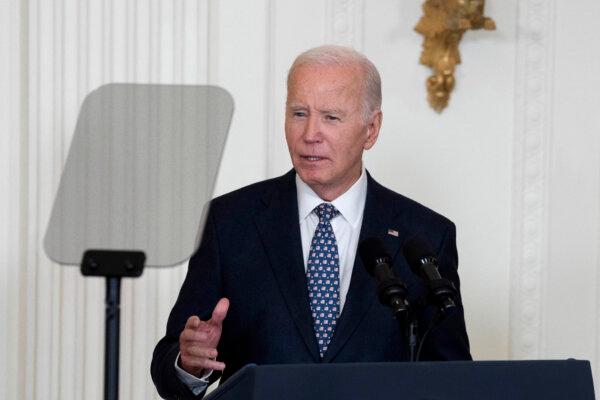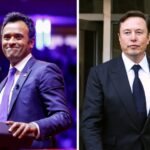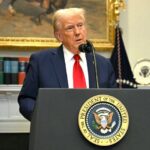By Andrew Moran
President-elect Donald Trump announced on Jan. 7 a $20 billion foreign investment to construct new data centers across the United States.
While speaking to reporters at his Mar-a-Lago residence, Trump said the funds would be allocated to establish new data centers in the Midwest and Sun Belt regions. According to Trump, the initial phase will take place in Arizona, Illinois, Indiana, Louisiana, Michigan, Ohio, Oklahoma, and Texas.
Emirati billionaire businessman Hussain Sajwani said he has waited for four years to bolster investments in the United States.
“It’s been amazing news for me and my family when Trump was elected in November,” the founder of global property development company DAMAC Properties told reporters at Mar-a-Lago.
“For the last four years, we’ve been waiting for this moment, and we’re planning to invest $20 billion, and even more than that, if the opportunity the market allows us.”
Trump reiterated his pledge to expedite the permit process if businesses or individuals invest at least $1 billion in the U.S. economy.
“This commitment further underscores that many of the greatest business leaders on Earth are seeing a very bright economic future for America,” he said.
Sajwani is the latest foreign business leader planning to make large investments in the United States after Trump defeated Vice President Kamala Harris in the November presidential election.
Last month, Trump announced that SoftBank, a Japanese tech-investing titan, will invest $100 billion in the U.S. economy over the next four years.
From his Mar-a-Lago residence, Trump and SoftBank CEO Masayoshi Son promised that the hefty investment would create at least 100,000 jobs, focusing on artificial intelligence (AI) and related infrastructure.
“My confidence level in the economy of the United States has tremendously increased with his victory,” Son stated.
Son and Trump made a similar announcement shortly after Trump’s 2016 election victory. The SoftBank chief agreed to invest $50 billion in the United States and create 50,000 jobs.
American technology companies plan to spend billions this year to accelerate their AI capacity.
“The perception of the whole world is different,” Trump said at Tuesday’s news conference.
Offshore Drilling
Trump said the Biden administration is trying to make it a difficult transition.
“I’ve been disappointed to see the Biden administration’s attempt to block the reforms of the American people and what they voted for,” Trump told reporters on Tuesday.
The president-elect confirmed again that he intends to undo President Joe Biden’s executive decision to ban future offshore oil and gas drilling in parts of the Atlantic and Pacific oceans.
“President Biden’s actions yesterday on offshore drilling, banning offshore drilling, will not stand,” Trump said. “I will reverse it immediately. It’ll be done immediately. And we will drill, baby, drill.
“They took away 625 million acres of offshore drilling. Nobody else does that … but we’ll put it back. I’m going to put it back on day one.”

Based on a 70-year-old law, Biden prohibited new oil and gas leasing across 625 million acres of U.S. oceans. The decision is permanent, and there has been debate about whether the incoming administration can legally reverse this measure.
Trump said the latest move harmed the economic viability of ocean drilling, which accounts for 15 percent of domestic energy output.
This environmental decision contradicts the president-elect’s plans to expand energy production, which he says will lower prices and help power the AI boom.
Trump thinks an accelerated energy boom will bring down grocery prices.
“I think you’re going to see some pretty drastic price reductions,” he stated.
Since January 2021, food prices have increased by 23 percent, according to the Bureau of Labor Statistics.
Additionally, an all-of-the-above approach to the energy portfolio will be crucial to facilitate the AI wave.
Over the last year, experts have predicted that the AI revolution will dramatically expand data center power demand.
Barclays Research analysts forecast that the AI wave will double data center electricity power demand by 2030.
Goldman Sachs Research says data center power demand will soar by 160 percent by 2030.
“At present, data centers worldwide consume 1-2% of overall power, but this percentage will likely rise to 3-4% by the end of the decade,” said Goldman Sachs analysts in a report published in May 2024. “In the US and Europe, this increased demand will help drive the kind of electricity growth that hasn’t been seen in a generation.”
Michael Barr Resigns
Michael S. Barr, the Federal Reserve’s vice chair for Supervision, announced on Jan. 6 that he will resign next month, more than a year before his term expires.
Barr plans to remain on the Federal Reserve Board of Governors until January 2032.
The central bank’s top regulatory cop said he wanted to avoid a “dispute” over his role.
“The risk of a dispute over the position could be a distraction from our mission,” Barr said in a letter to President Joe Biden. “In the current environment, I’ve determined that I would be more effective in serving the American people from my role as governor.”
Trump told reporters at Tuesday’s news conference that he will name Barr’s replacement soon.




![US Dollar Index Hits Highest Level in 2 Years, Euro Falls | USNN World News Strong labor data and positive expectations about the incoming Trump administration pushed the U.S. dollar to a two-year high on Thursday. The U.S. dollar iIndex hit a high of 109.53 on Jan. 2, the first trading day of the year, and the highest since November 2022. The jump came as data released on Thursday by the U.S. Department of Labor showed that initial jobless claims hit an eight-month low, suggesting a robust labor market, which is a positive sign for the overall economy. The dollar index was trading slightly lower on Friday at 108.96 as of 08:30 a.m. EST. The dollar index increase is also supported by investor confidence in the upcoming Trump administration, which assumes power this month. According to a recent survey by consulting company Teneo, “global CEOs and investors are optimistic about the economic impact of a second Trump administration, outweighing concerns about tariffs, geopolitical tensions, and trade barriers.” Story continues below advertisement In fact, “50 percent of global CEOs are accelerating activities in areas such as domestic and international investment and hiring based on the outcome of the 2024 U.S. election,” it said. While the dollar strengthened, the euro and sterling declined on Thursday. The euro fell to its lowest level in more than two years while the sterling declined to its lowest in eight months. A Dec. 17 report from JP Morgan predicts the U.S. dollar to reach even new highs over the coming months. Related Stories How Major US Stock Indexes Fared Jan. 2 1/2/2025 How Major US Stock Indexes Fared Jan. 2 Americans Have Hopes Trump Will Deliver on Immigration, Economy, Safety: Gallup 1/2/2025 Americans Have Hopes Trump Will Deliver on Immigration, Economy, Safety: Gallup “November’s election outcome has given way to lower global growth expectations, wider growth gaps between the U.S. and the rest of the world, and higher terminal federal funds rate forecasts for 2025—the perfect trifecta of bullish U.S. dollar cyclical impulse,” said Meera Chandan, co-head of Global FX Strategy at the company. “These are early first-order reactions that may give way to deeper rethinks once the full set of Trump administration policies are known next year [2025], but for now, they constitute a solid economic rationale for carrying a long U.S. dollar stance into the first quarter of 2025.” JP Morgan sees the euro’s outlook as bearish, noting the eurozone is especially vulnerable to trade conflicts. And while sterling was the best-performing currency against the dollar last year, such an outperformance is not expected this year, it said. US Economy Performance in 2025 With President-elect Donald Trump set to take power in less than three weeks, there are mixed views about how things could shape up for the American economy. According to a Dec. 9 post by Morgan Stanley, markets are “bullish on Trump’s second term, hoping for tax cuts and better growth.” “We expect no net stimulus and a decent size hit from tariffs and immigration. This should be bullish for bonds as the Fed continues cutting, but could be a disappointment for frothy stocks,” it said. Regarding tariffs, the most likely outcome is a 20 percent hike on Chinese imports and on vehicles from Mexico and the European Union, Morgan Stanley said. Story continues below advertisement It predicts the U.S. Federal Reserve to continue cutting interest rates to a range of 3 percent 3.5 percent by the end of 2025. S&P Global is forecasting the U.S. economy to grow by 2 percent in 2025 and 2026, following an estimated growth of 2.7 percent last year. The company sees inflation to likely remain above the 2 percent level for “longer than we previously thought.” Goldman Sachs predicts the U.S. economy to “beat expectations” this year. “The U.S. economy is in a good place,” said David Mericle, an economist with the company. “Recession fears have diminished, inflation is trending back toward 2 percent, and the labor market has rebalanced but remains strong.” While Trump’s policy changes are likely to be “significant,” Mericle does not see these actions changing the trajectory of the economy substantially. Goldman foresees the Fed reducing interest rates to a range of 3.25–3.50 percent, with the U.S. GDP predicted to grow by 2.5 percent. There have been three consecutive quarters of economic growth in the first nine months of 2024—1.6 percent in the first quarter, 3 percent in the second, and 3.1 percent in the third.](https://www.usnn.news/wp-content/uploads/2025/01/US-Dollar-Index-Hits-Highest-Level-in-2-Years-Euro-Falls-150x150.jpg)

